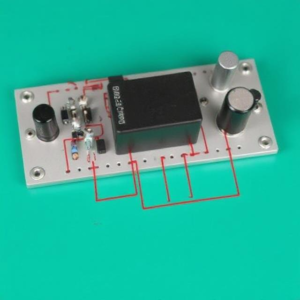Amplifiers are electronic circuits that increase the strength of a weak signal. The configuration of an amplifier refers to how the components (like resistors, capacitors, and transistors) are connected to each other and to the input/output signals. Different configurations have different applications, performance characteristics, and behaviors.
Here’s an easy-to-understand explanation of the types of amplifier configurations:

1. Common Emitter Amplifier (CE)
- Description: In this configuration, the input signal is applied to the base of the transistor, the output is taken from the collector, and the emitter is usually grounded.
- Characteristics:
- Voltage Amplification: It provides good voltage amplification (i.e., it increases the voltage of the input signal).
- Phase Shift: The output signal is inverted (180 degrees out of phase) with respect to the input signal.
- Impedance: It has a moderate input impedance and a high output impedance.
- Applications: It’s widely used in audio and RF (radio frequency) amplification, as it offers a good balance between gain and performance.
- Example: Audio amplifier circuits for amplifying sound signals.
2. Common Collector Amplifier (CC)
- Description: Also known as an emitter follower, the input is applied to the base, the output is taken from the emitter, and the collector is typically connected to a voltage source.
- Characteristics:
- Voltage Gain: This configuration has a unity gain (meaning the output voltage is nearly the same as the input voltage).
- No Phase Shift: The output signal is not inverted (it remains in phase with the input).
- Impedance: It has a high input impedance and low output impedance, making it useful as a buffer stage.
- Applications: Often used to match impedances between different stages of a circuit or as a voltage buffer to prevent loading of the signal source.
- Example: Impedance matching in audio systems or as a voltage buffer in power amplifiers.
3. Common Base Amplifier (CB)
- Description: In this configuration, the input signal is applied to the emitter, the output is taken from the collector, and the base is typically grounded or at a fixed voltage.
- Characteristics:
- Voltage Gain: Provides good voltage gain.
- No Phase Shift: The output signal is not inverted.
- Low Input Impedance: The input impedance is low, which means it requires a signal source that can provide higher current.
- High Output Impedance: It has a higher output impedance.
- Applications: Commonly used in high-frequency applications like radio frequency (RF) amplifiers or in certain types of signal processing.
- Example: RF amplifier circuits, such as those in radio transmitters or receivers.
4. Voltage Amplifier
- Description: A voltage amplifier is designed to increase the voltage of an input signal without significantly changing the current.
- Characteristics:
- High Voltage Gain: It provides significant voltage amplification, which means it makes weak voltage signals stronger.
- Low Current Gain: Voltage amplifiers typically do not significantly increase current.
- Applications: Used when you need to increase the voltage of a signal, such as in audio systems or signal processing.
- Example: A pre-amplifier in an audio system, which amplifies a microphone’s low voltage signal to a higher level.
5. Current Amplifier
- Description: A current amplifier increases the current of the input signal while keeping the voltage relatively unchanged.
- Characteristics:
- High Current Gain: This amplifier increases the current rather than the voltage.
- Low Voltage Gain: The output voltage is typically close to the input voltage.
- Applications: Used in applications where high current is required to drive low-impedance loads, such as in driving speakers or actuators.
- Example: A power amplifier for driving a speaker, where the signal’s current needs to be increased to produce sound.
6. Differential Amplifier
- Description: A differential amplifier amplifies the difference between two input signals while rejecting any signals that are common to both (i.e., noise).
- Characteristics:
- High Common-Mode Rejection: It rejects signals that are common to both inputs (like noise or interference).
- Good for Signal Differentiation: This is useful in systems where you want to isolate the difference between two signals, such as in measurement or instrumentation applications.
- Applications: Often used in operational amplifier circuits (op-amps), instrumentation amplifiers, and in systems where differential signals are needed.
- Example: An operational amplifier (op-amp) used in a sensor interface circuit to measure small differences in voltage.
7. Operational Amplifier (Op-Amp)
- Description: An operational amplifier is a versatile amplifier used in many configurations. It’s typically used with external components (resistors, capacitors) to create various types of circuits like voltage followers, integrators, differentiators, etc.
- Characteristics:
- High Gain: Op-amps have high voltage gain.
- Low Output Impedance: They are designed for use with other circuits.
- Flexible Configuration: Op-amps can be configured as voltage amplifiers, differential amplifiers, inverting or non-inverting amplifiers, integrators, and differentiators.
- Applications: Op-amps are used in a wide range of applications, including audio systems, signal conditioning, analog computing, and control systems.
- Example: A non-inverting amplifier in a sensor signal processing circuit.
8. Inverting and Non-Inverting Amplifier Configurations
- Inverting Amplifier:
- The input signal is applied to the inverting input of the op-amp, and the output is inverted (180 degrees out of phase with the input).
- It provides voltage amplification but with inverted polarity.
- Non-Inverting Amplifier:
- The input signal is applied to the non-inverting input of the op-amp, and the output signal is in phase with the input.
- It also provides voltage amplification but without inversion.
- Applications: These configurations are used in situations where you need to control both the gain and the phase (inverting or non-inverting) of the amplifier.
9. Power Amplifier
- Description: A power amplifier is designed to increase both the voltage and current of the input signal, which is necessary to drive power-hungry loads like speakers or motors.
- Characteristics:
- High Power Output: It is used to drive large loads, like speakers in audio systems, where both voltage and current must be increased.
- Impedance Matching: Power amplifiers match the impedance between the signal source and the load (like a speaker) to maximize power transfer.
- Applications: Used in audio systems, radio transmitters, or any application where significant power is needed to drive a load.
- Example: Audio power amplifiers in stereo systems, radio broadcast amplifiers.
Summary of Key Differences:
- Voltage Gain: Common Emitter, Common Base, and Operational Amplifiers provide high voltage gain, while Common Collector (Emitter Follower) is used for impedance matching with no significant voltage gain.
- Phase Shift: Common Emitter amplifiers invert the signal, while Common Collector and Common Base configurations do not invert.
- Impedance: Common Collector amplifiers have high input impedance and low output impedance, making them good buffers, while Common Emitter amplifiers typically have a moderate impedance profile.
- Applications: Voltage amplifiers are used for weak signal amplification, while power amplifiers are used to drive power-hungry devices like speakers.
Understanding the amplifier configuration helps in choosing the right circuit for your application, based on whether you need voltage amplification, current amplification, or impedance matching.
Tags: (Op-Amps), Amplifier Characteristics, Amplifier Configurations., Amplifiers, Audio Amplifiers, Audio Equipment, Audio Power Amplifiers, Audio Signal Amplification, Audio Signal Boosters, Audio Systems, Common Base Amplifier, Common Collector Amplifier, Common Emitter Amplifier, Current Amplifiers, Current Gain, Differential Amplifiers, Electronic Circuit Design, Gain Control, High Frequency Amplifiers, High Impedance, High Power Output, Impedance Buffer, Impedance Matching, Impedance Matching Circuits, Inverting Amplifiers, Low Impedance, Non-Inverting Amplifiers, Operational Amplifiers, Phase Shift, Power Amplifiers, Power Electronics, Power Systems, RF Amplifiers, Sensor Interface Circuits, Signal amplification, Signal Boost, Signal Conditioning, Signal Differentiation, Signal Processing, transistors, Voltage Amplification, Voltage Amplifiers, Voltage Follower, Voltage Gain


